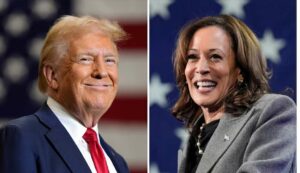US: Kamala Harris takes lead in swing state Wisconsin in early trends
US: Donald Trump led in Georgia, a crucial swing state with 16 electoral college votes, according to early indications from the US presidential election. Michigan and Pennsylvania, two crucial swing states, contributed 15 and 19 electoral votes, respectively, to Kamala Harris’s victory.

Trump and Kamala Harris focused all of their efforts during the final stages of the election campaign to gain support in a small number of US states known as the “purple” or “battleground” states. In these states, a statewide election might be won by a Republican or Democratic candidate.
Due to their significant number of electoral college votes, swing states, which have a population of just over 60 million Americans, also have the ability to influence the outcome of the US presidential election. One example is Trump’s win in the 2016 US presidential election.
Trump won 306 electoral college votes, even though Democrat Hilary Clinton, his opponent, received over three million more popular votes. Pennsylvania (19), Nevada (6), North Carolina (16), Georgia (16), Arizona (11), Michigan (15), and Wisconsin (10), are seven of these states in this year’s election.
Prior to the vote, polls in these states predicted that Trump and Harris were in a statistical tie, making the result uncertain. Four fresh national polls issued on Sunday and Monday show Harris ahead of Trump by a single digit, while three other polls are dead heat.
According to analysts, the ultimate result in these states will be skewed by the large number of undecided voters. In 2023, 43% of US people on average identified as independent, matching a record high set in 2014, according to a Gallup survey. Approximately 1.4 million of Pennsylvania’s almost nine million registered voters declared themselves independents.
Minority and female voting participation is another element that may influence the outcomes in these states. According to a Politico examination of early voting in many states, 45% of early voters are males and 55% are women. In a handful of swing states, where women vote in greater numbers than males, the gender difference is especially noticeable.
To influence unsure voters, the two front-runners invested a lot of money in their campaigns in these states. A Reuters investigation claims that before voting, citizens in these states have been inundated with robocalls, billboards, campaign visits, social media messaging, and SMS messages.




